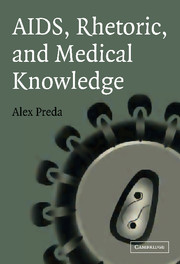Book contents
- Frontmatter
- Contents
- Acknowledgments
- List of Abbreviations
- Introduction
- 1 Making Up the Rules of Seeing
- 2 The Economy of Risk Categories
- 3 The Etiologic Agent and the Rhetoric of Scientific Debate
- 4 Retrovirus vs. Retrovirus
- 5 The Spatial Configurations of “AIDS Risk”
- 6 Who Is How Much?
- 7 In Lieu of a Conclusion
- References
- Index
3 - The Etiologic Agent and the Rhetoric of Scientific Debate
Published online by Cambridge University Press: 25 July 2009
- Frontmatter
- Contents
- Acknowledgments
- List of Abbreviations
- Introduction
- 1 Making Up the Rules of Seeing
- 2 The Economy of Risk Categories
- 3 The Etiologic Agent and the Rhetoric of Scientific Debate
- 4 Retrovirus vs. Retrovirus
- 5 The Spatial Configurations of “AIDS Risk”
- 6 Who Is How Much?
- 7 In Lieu of a Conclusion
- References
- Index
Summary
The Sociology of Scientific Debates
In this chapter, I show how the system of risk categories generated and supported a number of contradictory theses about the etiologic agent. One of the first questions arising here is: how were these theses debated in medical articles? Did they unleash a controversy? How was it resolved, and what factors played a role in this process?
Scientific controversies have been studied intensively in the sociology of science (e.g., Collins 1988; Latour 1988; Barnes, Bloor, and Henry 1996). A scientific controversy is usually understood as “a publicly and persistently maintained dispute … concerned with a matter of belief” (McMullin 1987, p. 51). It implies an ongoing disagreement, with continuing argument and counterargument, usually on two sides. These sides have public exchanges, so that the scientific community can judge the case. In many cases, scientific controversies involve the replication of a key experiment (Gieryn 1999); the mobilization of material, social, and cultural resources; or changes in group competencies and social relations as major factors influencing the controversies' outcomes.
Some controversies are decided in a couple of months or even weeks; others may take several years or even decades. Controversies may be resolved or closed: in the first case, the scientific community agrees on the merits of the case. In the second case, there is no community agreement, yet the topic at stake becomes less important, slips quietly out of the limelight, or does not receive the material and time resources it needs to be resolved.
- Type
- Chapter
- Information
- AIDS, Rhetoric, and Medical Knowledge , pp. 113 - 155Publisher: Cambridge University PressPrint publication year: 2004



